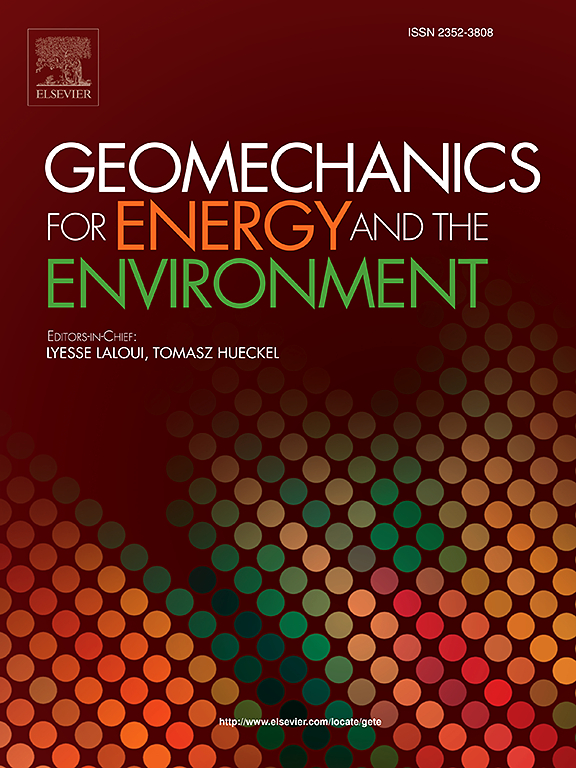Discrimination of critically stressed faults and safety-optimized hydraulic fracturing design: Insights from meter-scale physical modeling
IF 3.7
2区 工程技术
Q3 ENERGY & FUELS
引用次数: 0
Abstract
This study presents an integrated approach combining metre-scale physical experiments, numerical simulations and theoretical modelling to systematically investigate the mechanisms and controlling factors of fault slip induced by hydraulic fracturing, with the ultimate goal of establishing fundamental design principles for fault slip mitigation. First, we quantify the influence of fault geometry and mechanical properties on stress concentration by deriving a quantitative stress concentration equation through multivariate regression analysis. Second, a novel three-dimensional (3D) Coulomb failure stress (CFS) expression incorporating stress concentration coefficients is proposed to overcome the limitations of conventional regional stress analysis. Third, the theoretical stress transfer model is validated against experimental data, showing strong agreement between predicted and measured CFS changes, with a relative error of less than 10 %. Our results demonstrate that hydraulically isolated faults are primarily controlled by regional stress states during slip initiation. Critically stressed faults exhibit significant slip near injection points, while non-critical faults remain stable. The proposed 3D CFS expression successfully discriminates between stress-transfer induced PNR-1z and pore-pressure driven PNR-2 seismic events. Finally, faults are classified into four distinct types, each associated with tailored hydraulic fracturing design protocols: type I faults require mandatory avoidance; type II-III faults require controlled injection parameters; and type IV faults permit cost-optimised operations. These findings provide theoretical advances and practical guidelines for mitigating induced seismicity in hydraulic fracturing.
临界应力断层的识别和安全优化水力压裂设计:来自米尺度物理建模的见解
本研究采用米尺度物理实验、数值模拟和理论建模相结合的综合方法,系统研究水力压裂诱发断层滑动的机理和控制因素,最终建立断层滑动缓解的基本设计原则。首先,通过多元回归分析,推导出定量应力集中方程,量化断层几何形状和力学性质对应力集中的影响。其次,针对传统区域应力分析的局限性,提出了一种包含应力集中系数的三维库仑破坏应力(CFS)表达式。第三,将理论应力传递模型与实验数据进行对比验证,结果表明,CFS变化预测值与实测值吻合较好,相对误差小于10 %。研究结果表明,水力隔离断层主要受起滑过程中区域应力状态的控制。临界应力断层在注入点附近表现出明显的滑移,而非临界断层则保持稳定。提出的三维CFS表达式成功区分了应力传递诱发的PNR-1z和孔隙压力驱动的PNR-2地震事件。最后,将断层分为四种不同的类型,每种类型都与定制的水力压裂设计方案相关:I型断层需要强制规避;II-III型故障需要控制注入参数;IV型故障可以实现成本优化操作。这些发现为减轻水力压裂诱发地震活动提供了理论进展和实践指导。
本文章由计算机程序翻译,如有差异,请以英文原文为准。
求助全文
约1分钟内获得全文
求助全文
来源期刊

Geomechanics for Energy and the Environment
Earth and Planetary Sciences-Geotechnical Engineering and Engineering Geology
CiteScore
5.90
自引率
11.80%
发文量
87
期刊介绍:
The aim of the Journal is to publish research results of the highest quality and of lasting importance on the subject of geomechanics, with the focus on applications to geological energy production and storage, and the interaction of soils and rocks with the natural and engineered environment. Special attention is given to concepts and developments of new energy geotechnologies that comprise intrinsic mechanisms protecting the environment against a potential engineering induced damage, hence warranting sustainable usage of energy resources.
The scope of the journal is broad, including fundamental concepts in geomechanics and mechanics of porous media, the experiments and analysis of novel phenomena and applications. Of special interest are issues resulting from coupling of particular physics, chemistry and biology of external forcings, as well as of pore fluid/gas and minerals to the solid mechanics of the medium skeleton and pore fluid mechanics. The multi-scale and inter-scale interactions between the phenomena and the behavior representations are also of particular interest. Contributions to general theoretical approach to these issues, but of potential reference to geomechanics in its context of energy and the environment are also most welcome.
 求助内容:
求助内容: 应助结果提醒方式:
应助结果提醒方式:


